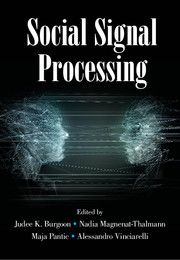Book contents
- Frontmatter
- Contents
- Contributors
- 1 Introduction: Social Signal Processing
- Part I Conceptual Models of Social Signals
- Part II Machine Analysis of Social Signals
- Part III Machine Synthesis of Social Signals
- Part IV Applications of Social Signal Processing
- 24 Social Signal Processing for Surveillance
- 25 Analysis of Small Groups
- 26 Multimedia Implicit Tagging
- 27 Social Signal Processing for Conflict Analysis and Measurement
- 28 Social Signal Processing and Socially Assistive Robotics in Developmental Disorders
- References
27 - Social Signal Processing for Conflict Analysis and Measurement
from Part IV - Applications of Social Signal Processing
Published online by Cambridge University Press: 13 July 2017
- Frontmatter
- Contents
- Contributors
- 1 Introduction: Social Signal Processing
- Part I Conceptual Models of Social Signals
- Part II Machine Analysis of Social Signals
- Part III Machine Synthesis of Social Signals
- Part IV Applications of Social Signal Processing
- 24 Social Signal Processing for Surveillance
- 25 Analysis of Small Groups
- 26 Multimedia Implicit Tagging
- 27 Social Signal Processing for Conflict Analysis and Measurement
- 28 Social Signal Processing and Socially Assistive Robotics in Developmental Disorders
- References
Summary
Introduction
The literature proposes several definitions of conflict: “a process in which one party perceives that its interests are being opposed or negatively affected by another party” (Wall & Roberts Callister, 1995); “[conflict takes place] to the extent that the attainment of the goal by one party precludes its attainment by the other” (Judd, 1978); “[…] the perceived incompatibilities by parties of the views, wishes, and desires that each holds” (Bell & Song, 2005); and so on. While apparently different, all definitions share a common point, that is, the incompatibility between goals and targets pursued by different individuals involved in the same interaction.
Following the definitions above, conflict is a phenomenon that cannot be observed directly (goals and targets are not accessible to our senses), but only inferred from observable behavioural cues. Therefore, the phenomenon appears to be a suitable subject for a domain like social signal processing that includes detection and interpretation of observable social signals among its research focuses (Vinciarelli et al., 2008; Vinciarelli, Pantic, & Bourlard, 2009; Vinciarelli, Pantic et al., 2012). Furthermore, the literature shows that emotions are ambiguous conflict markers – people tend to display both positive and negative emotions with widely different levels of arousal (Arsenio & Killen, 1996) – while social signals are more reliable markers of conflict (Gottman, Markman, & Notarius, 1977; Sillars et al., 1982; Cooper, 1986; Smith-Lovin & Brody, 1989; Schegloff, 2000).
One of the main challenges toward the development of automatic conflict analysis approaches is the collection of ecologically valid data (Vinciarelli, Kim et al., 2012). The main probable reason is that there is no conflict in absence of real goals and motivations, but these are difficult to produce in laboratory experiments. To the best of our knowledge, the few corpora where the subjects are moved by real motivations and, hence, actually experience conflict are collections of political debates (Vinciarelli, Kim et al., 2012) and recordings of counseling sessions for couples in distress (Black et al., 2013). However, while the former can be distributed publicly and have even been used in international benchmarking campaigns (Schuller et al., 2013), the latter are protected for privacy reasons.
- Type
- Chapter
- Information
- Social Signal Processing , pp. 379 - 388Publisher: Cambridge University PressPrint publication year: 2017
References
- 1
- Cited by



